Be on the lookout for False Codling Moth and other caterpillars
False codling moth also known as Thaumatotibia leucotreta is a native pest to sub-Saharan Africa and is present on more than 70 host plants crops like roses, citrus, peppers (Capsicum spp.), maize etc. making it a challenge to control it. It also occurs on some of the Indian and Atlantic Ocean islands, such as Mauritius and Cape Verde. False codling moth was previously known as Cryptophlebia leucotreta. FCM is an economically important pest for roses as it causes crop damage and is categorized as a quarantine pest by the European Union (EU).
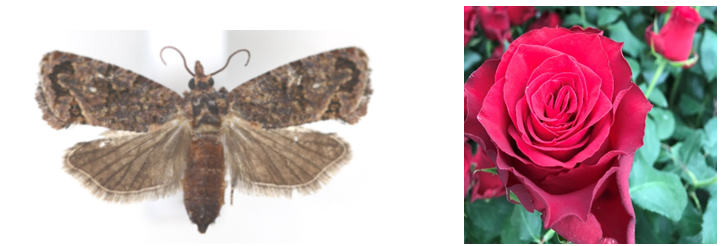
False codling moth, adult female
Economic impact of FCM interceptions
Already several rose growers have incurred financial losses due interceptions in the EU of their produce. These interceptions have led to an increase in checks from 5% to 10% on import inspections into the EU. These checks affect all Kenyan rose exporters. An integrated approach by the floriculture sector in dealing with the challenge of FCM is therefore crucial.
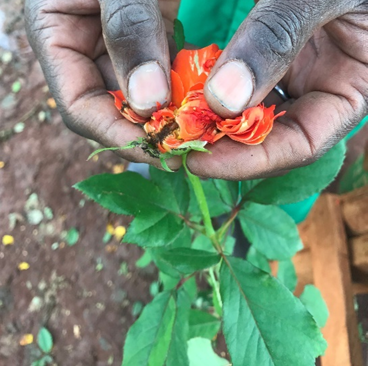
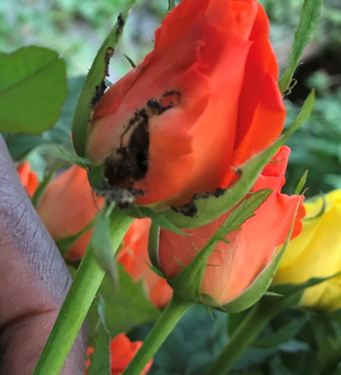
External frass is a sign of larvae inside the flower head
Biology and life cycle of false codling moth
The female moth lays over 100 eggs at night, usually singly on flower petals or other parts of the rose bush. Eggs are flat, oval discs (0.77 mm long by 0.60 mm wide) with a surface that feels slightly rough. When first laid they are white/cream coloured, and before hatching they change to a reddish colour with a black head capsule. Eggs take from 2 to 22 days to hatch, depending on temperature. They are very sensitive to cold and dry conditions. Temperatures below freezing over 2–3 days can kill the eggs.
When the eggs hatch, the larvae burrow into the flower bud, where they grow and complete their development. Eggs laid on the surface of crown galls allow subsequent larvae to enter the cracks of the gall.
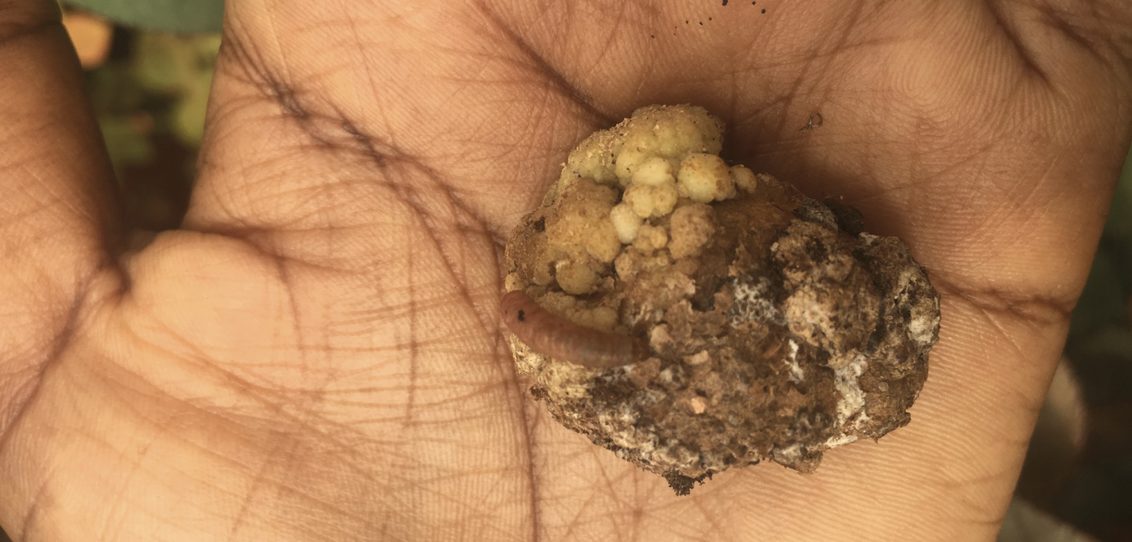
FCM larvae exposed when opening a rose crown gall
In the flower buds they make small holes about 1 mm in diameter. The entrances to these holes are often the first sign of the pest because the larvae leave deposits of faeces (frass). There may also be petal discoloration.
The larvae go through five stages. In the first stage they are 1–1.2 mm long and have a spotted appearance. By the fifth stage, live caterpillars are 12–18 mm long, orange-pink, with pale sides and yellow in the middle. At this stage a brown head capsule is visible.
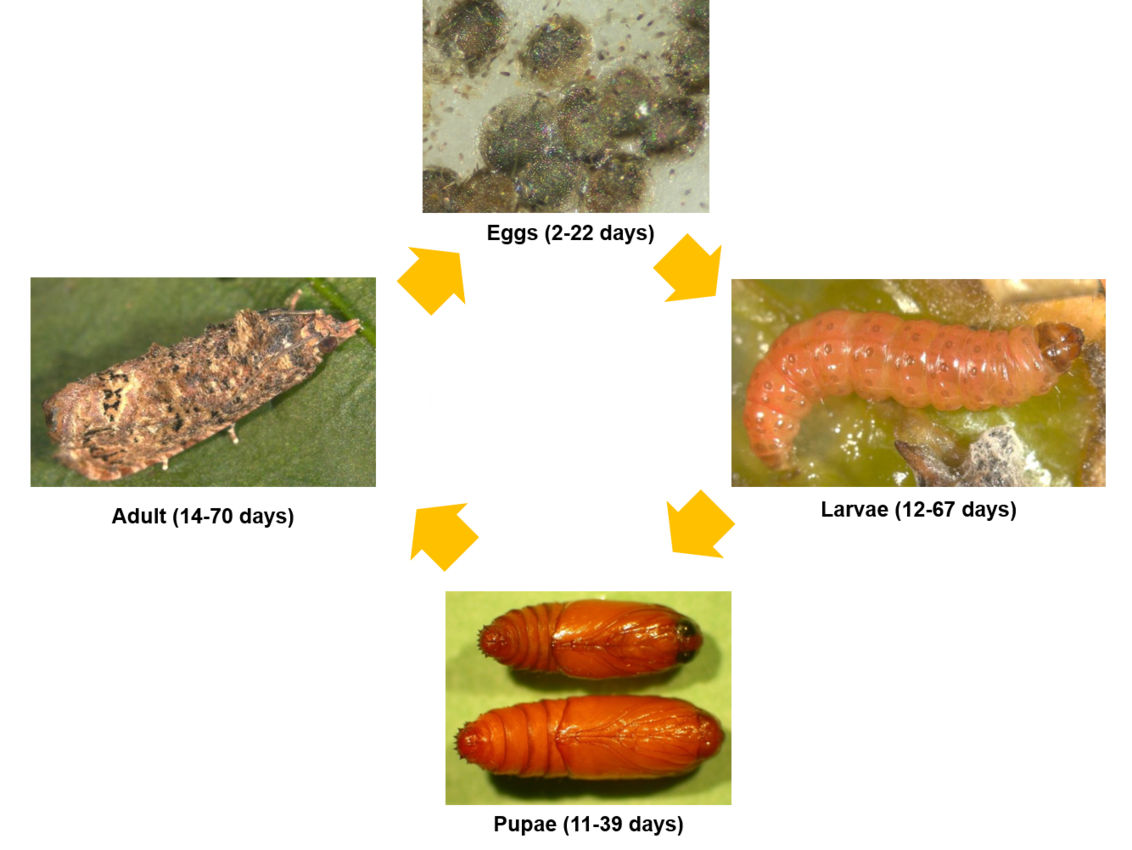
Life cycle of Thaumatotibia leucotreta (false codling moth)
The larvae develop inside the flower; this can take 12–33 days in the warm conditions of a rose greenhouse. Generally, only one to three larvae survive in each flower. When fully grown, larvae bore their way out of the flower, descend to the ground on a silken thread, and spin tough silken cocoons in the soil, among debris or in bark crevices for later adult emergence.
Management strategies for false codling moth
Management of FCM in roses must involve an integrated approach across all stages of the value chain and through the involvement of all stakeholders. The key to success is in the production and packing stages of the rose crop. The main components of the management strategy involve staff training and communication, as well as a range of integrated control techniques.
Monitoring
Pheromone traps
Pheromone traps catch only male FCM; but the capture of males indicates the presence of female FCM that will lay eggs and infest a crop. It is important to clearly establish responsibilities for placing, checking, reporting and replacing traps within the team (farm manager, crop scouting team, crop protection team) to avoid confusion.
Prevention
Orchard sanitation and biological control play critical roles in the prevention of FCM outbreaks in ornamentals. All infested and damaged flowers should be collected and destroyed. Naturally occurring egg parasitoids, Trichogramma cryptophlebiae should also be augmented or occasionally released to help prevent FCM outbreaks.
Cultural control
Cultural control should be carried out regularly to avoid the build-up of FCM populations over the season.
Several practices must be considered when practicing cultural control:
- Use clean planting material (ensure planting material is free from crown galls).
- Maintain a high level of field sanitation (crop hygiene) and ensure all prunings and crop debris are removed from the greenhouse. Take plant debris from greenhouses infected with FCM well away from the greenhouse and dispose of it by burying or placing in black bags to allow solarization to occur. Crop residues may serve as a reservoir for the pest.
-After solarization, which requires a period of up to 48 hours of sunny conditions, the polythene can be removed, and the debris composted.
- Identify, scout and be prepared to manage FCM in nearby wild hosts. Assess the risk of areas surrounding the greenhouse as potential hosts for FCM. Place monitoring pheromone traps near the greenhouse to assess the presence of FCM. If the surrounding areas are considered a potential source of FCM, consider regular scouting and ultimately management of this infestation.
- Crown galls can be sites for development of larvae and pupae. Remove the galls and place them in plastic bags and expose them to the sun to suffocate before disposal. The larvae gain some protection from insecticides within the crown gall or the stem, or in the petals.
Physical control
Physical control should be carried out in the following ways:
- Repair/replace worn-out polythene and insect screens.
- Fix fitting doors, and always close the doors to prevent pests from entering the greenhouse.
- Use signs (e.g. “Close the door behind you”) to encourage implementation.
- Install insect screens to keep off moths flying into the greenhouses’ shade nets and insect nets.
- Mechanically pick and kill any caterpillars, eggs, and moths.
Pheromone traps for FCM can also be used for mass trapping. The recommended rate is a minimum of 10 traps per hectare (follow manufacturer’s recommendations). The pheromone in the traps disrupts the attraction of male moths to virgin females. The pheromone traps (usually delta traps) contain a glue, which physically captures the adult male moth. There are no pesticides in an FCM pheromone trap.
Biological control
Several biological control agents are known to be effective against FCM.
These include:
- The bacterium Bacillus thuringiensis var. kurstaki and B. thuringiensis var. aizawai.
- The virus Cryptophlebia leucotreta granulovirus (CrleGV).
- The entomopathogenic fungal species Beauveria bassiana, Metarhizium anisopliae
- The egg parasitoid species Trichogrammatoidea cryptophlebiae
Chemical control
There are several conventional pesticide products registered in Kenya for the control of FCM and caterpillars on roses. Our current chemical recommendations for control of FCM in ornamentals consists of Karate Zeon and Match.
- Always read the label and directions for use.
- Use the application rates recommended.
- Take note of which life-cycle stage (adults, eggs, larvae) the application is targeting.

